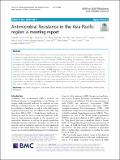Antimicrobial Resistance in the Asia Pacific region: a meeting report
Author(s)
Dedon, Peter
DownloadPublished version (642.2Kb)
Publisher with Creative Commons License
Publisher with Creative Commons License
Creative Commons Attribution
Terms of use
Metadata
Show full item recordAbstract
The Asia Pacific region, home to two-thirds of the world's population and ten of the least developed countries, is considered a regional hot-spot for the emergence and spread of antimicrobial resistance (AMR). Despite this, there is a dearth of high-quality regional data on the extent of AMR. Recognising the urgency to close this gap, Singapore organised a meeting to discuss the problems in the region and frame a call for action. Representatives from across the region and beyond attended the meeting on the "Antimicrobial Resistance in the Asia Pacific & its impact on Singapore" held in November 2018. This meeting report is a summary of the discussions on the challenges and progress in surveillance, drivers and levers of AMR emergence, and the promising innovations and technologies that could be used to combat the increasing threat of AMR in the region. Enhanced surveillance and research to provide improved evidence-based strategies and policies are needed. The major themes that emerged for an action plan are working towards a tailored solution for the region by harnessing the One Health approach, enhancing inter-country collaborations, and collaboratively leverage upon new emerging technologies. A regionally coordinated effort that is target-driven, sustainable and builds on a framework facilitating communication and governance will strengthen the fight against AMR in the Asia Pacific region.
Date issued
2019-12Department
Massachusetts Institute of Technology. Department of Biological EngineeringJournal
Antimicrobial resistance & infection control
Publisher
Springer Science and Business Media LLC
Citation
Yam, Esabelle Lo Yan et al. “Antimicrobial Resistance in the Asia Pacific region: a meeting report.” Antimicrobial resistance & infection control 8 (2019): 202 © 2019 The Author(s)
Version: Final published version
ISSN
2047-2994